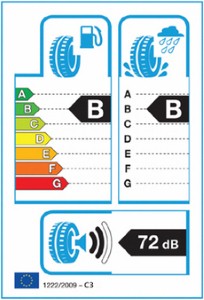Understanding the new eco labels for tyres
01/11/2012 15:53
Share

Understanding the new eco labels for tyres
New tyre labelling rules have been introduced in the UK today (November 1st), with drivers needing to take into account three topic areas.
The label, which comes in the form of a sticker, needs to be applied to every tyre that was produced after July 1st 2012 to display the product's impact on the environment.
Such a complex strategy is being rolled out as a way of educating consumers about EU-wide regulation that is due to come into force in just four months time.
A spokesman for the Society of Motor Manufacturers and Traders (SMMT) commented: "The SMMT is looking forward to the labelling because it will help lower vehicle emissions, but safety is a key focus for us. The labelling is a step forward."
Each label rates a tyre for its fuel efficiency, noise and wet braking through three easy-to-read graphs. Here's a look at each area in detail.
Fuel efficiency rating
On the top left-hand side of the sticker, a tyre's fuel efficiency level is measured by recording how much rolling resistance it can produce.
A grade is given once this process has been undertaken, with A the highest rating and G given to the lowest performing tyre. D has been left out of the rankings to avoid addressing average performing wheels.
Tim Bailey, from tyre maker Continental, explained: "The difference between each grade means a reduction or increase in fuel consumption of between 2.5 and 4.5 per cent. That's a difference of about 0.42 to 0.56mpg for a 36mpg car per grade."
Noise rating
Gracing the bottom half of the label is an image that features a tyre alongside a sound symbol.
Three bars complete this part of the sticker, with the bars blacked out according to how loud the tyre is. The external noise is measured in decibels, which is indicated alongside the image.
Wet braking rating
Monitoring how well a tyre grips a road during wet conditions is where the safety part of the sticker takes centre stage.
Located on the top right-hand side of the sticker, drivers will be able to glimpse how good a tyre is at bringing a car to a standstill on slippery road surfaces.
Wet braking is measured in terms of distance, with grades for this test once again ranging from A to G, as well as D being omitted to avoid an average rating being recorded.
Furthermore, the difference between each grade in this instance reflects between one and two car lengths – equivalent to between three and six metres – when analysing maximum braking from 50mph.
Posted by Craig Salter